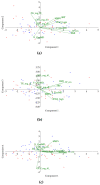Body Composition and Metabolic Status of Italian and Spanish University Students: Relationship with Fruit and Vegetable Consumption
- PMID: 36014802
- PMCID: PMC9415832
- DOI: 10.3390/nu14163296
Body Composition and Metabolic Status of Italian and Spanish University Students: Relationship with Fruit and Vegetable Consumption
Abstract
Most university students do not follow recommendations for fruit and vegetable intake, with a consequent increase in the prevalence of cardiovascular disease (CVD) risk factors. The aim of this study was to compare obesity prevalence and biomarkers of metabolic status between Italian and Spanish university students, in relation with the consumption of fruits and vegetables. Food consumption, adherence to a Mediterranean diet (MD), level of physical activity (PA), blood glucose, total cholesterol, triglycerides and ketones, blood pressure, and body composition were evaluated. Among CVD risk factors, only glucose was significantly higher in Spaniards (SP), and only 3.1% of SP presented ketosis. SP had a higher percentage of energy from fat. Although adherence to MD and fruit and vegetable consumption did not differ between Italians and SP, students who consumed at least four servings of fruit and vegetables (FV group) showed better values for pressure and metabolic parameters than the no FV group. We observed an association between consumption of fruit and PA. Students who consumed more vegetables than fruit reported a better body composition profile and lower glucose concentrations. As previously suggested, in addition to PA, two servings of fruit and three servings of vegetables per day should be recommended.
Keywords: Mediterranean diet; bioelectrical impedance analysis; body composition; metabolic status; physical activity; polyphenols.
Conflict of interest statement
The authors declare no conflict of interest.
Figures



Similar articles
-
[Fruit and vegetable consumption and related influencing factors among urban junior students in Hangzhou].Zhonghua Liu Xing Bing Xue Za Zhi. 2013 Mar;34(3):236-40. Zhonghua Liu Xing Bing Xue Za Zhi. 2013. PMID: 23759228 Chinese.
-
Fruit and vegetable intake in young children.J Am Coll Nutr. 1998 Aug;17(4):371-8. doi: 10.1080/07315724.1998.10718778. J Am Coll Nutr. 1998. PMID: 9710848
-
Are University Students in Singapore Meeting the International and National Recommended Daily Servings of Fruits and Vegetables?Asia Pac J Public Health. 2017 Apr;29(3):199-210. doi: 10.1177/1010539517696553. Epub 2017 Mar 7. Asia Pac J Public Health. 2017. PMID: 28434248
-
Incorporating healthy dietary changes in addition to an increase in fruit and vegetable intake further improves the status of cardiovascular disease risk factors: A systematic review, meta-regression, and meta-analysis of randomized controlled trials.Nutr Rev. 2020 Jul 1;78(7):532-545. doi: 10.1093/nutrit/nuz104. Nutr Rev. 2020. PMID: 31889199
-
Fruit and vegetable consumption and risk of cardiovascular disease: A meta-analysis of prospective cohort studies.Crit Rev Food Sci Nutr. 2017 May 24;57(8):1650-1663. doi: 10.1080/10408398.2015.1008980. Crit Rev Food Sci Nutr. 2017. PMID: 26114864 Review.
Cited by
-
Association between cMIND diet and hypertension among older adults in China: a nationwide survey.Aging Clin Exp Res. 2024 Sep 5;36(1):182. doi: 10.1007/s40520-024-02842-3. Aging Clin Exp Res. 2024. PMID: 39235675 Free PMC article.
-
Plant Polyphenols and Human Health: Novel Findings for Future Therapeutic Developments.Nutrients. 2023 Aug 28;15(17):3764. doi: 10.3390/nu15173764. Nutrients. 2023. PMID: 37686796 Free PMC article.
References
-
- World Health Organization . Body Mass Index. World Health Organization; Geneva, Switzerland: 2014.
MeSH terms
Substances
LinkOut - more resources
Full Text Sources
Research Materials

